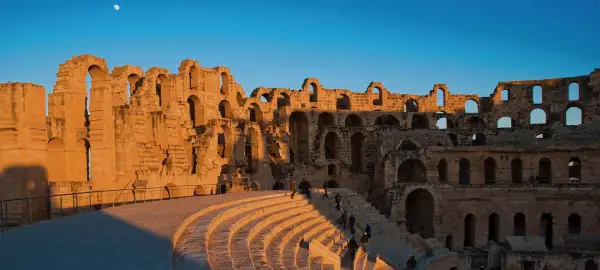Small Group Experiential Travel
Tour Code
TN1 When To Go
Apr, Oct Start
Tunis (TUN) End
Tunis (TUN) Countries Visited (1)
Tunisia Overnight In (5)
Tunis, Sfax, K...More > Activity Level
1 - Light? Tour Type
Cultural? - Overview
- Info & Inclusions
- Itinerary
- Map & Hotels
- Photos
- Dates & Prices
Highlights
- Max Group Size 18
- Legendary Carthage
- Mosaics of Bardo Museum
- Roman sites Sufetula, Dougga, Bulla Regia
- Djerba island excursion
- El Djem Museum and Amphitheatre
- Singles friendly (view options for single travellers)
Description
Experience the captivating blend of history, culture, and natural beauty that Tunisia has to offer. Our tour takes you on a journey through the ancient streets of Carthage, where the echoes of the Roman Empire still linger in the temples, theatres, and worn stone streets. Discover the picturesque lakes and hills that made this land an irresistible oasis, and marvel at the ingenious troglodyte dwellings of Matmata, carved directly into the sandstone hillsides. As you explore, uncover the remnants of grand architectural achievements, such as the impressive aqueducts that once spanned 80 km. From the vibrant markets to the tranquil landscapes, Tunisia's unique charm will leave you enchanted and inspired.
Price Includes
- Full-time Tour Leader services with local guide support at some locations
- Breakfast and dinner (hotels & local restaurants) daily. All transport, accommodation, sightseeing and entrance fees for sites noted as 'visited' in the detailed itinerary. Gratuities for local guides, drivers, restaurant staff, porters. Airport transfers for land & air customers and for early arriving / late departing land & air customers who book their extra hotel nights through us.
Exclusions
- International airfare to/from the tour. Tour Leader gratuities, lunches, drinks, personal items (phone, laundry, etc), international (if applicable) excursions referenced as 'optional'. Airport transfers for Land Only customers. Our post-reservation trip notes offer further guidance on optional meal costs and shopping.
Trip Info
- Seasonality and Weather:
This tour is offered in spring and late fall when temperatures are mild, crowds thinner, and airfares lower. Spring is popular with visitors who enjoy green landscapes and wildflowers. The region has a mild Mediterranean climate with early springs and autumns that are bright but cool. Showers are possible in spring and possible in fall. - Transport and Travel Conditions:
Transport throughout by private air-conditioned motor coach, 24-36 seats depending on ultimate group size (see 'group size'). Though we will have some full bus days, road travel is not particularly arduous as there are plenty of stops of interest. Roads are in good condition. Short ferry crossing to Djerba. Walking tours on uneven surfaces.
Am I suitable for this tour? Please refer to our self-assessment form - Activity Level: 1
No particular physical activity is involved other than town/city walks and short walks to dinners and sites of interest, some of which are large.
To learn more about the Activity levels, please visit our tour styles page. - Accommodation:
Well-located, air- conditioned, mid-range hotels and inns (3-4 star) used throughout. All hotels have en suite bath, though some may have shower only. Porter service is usually available (see 'inclusions') though you should be independent with your luggage, especially at airports. Single rooms are limited and likely smaller than twins. - Staff and Support:
Tour Leader throughout, local guide throughout (Tunisia), driver. - Group Size:
Maximum 18 plus Tour Leader
View / Print Itinerary
- Day 1:Arrive in TunisArrival in Tunis.
The capital of Tunisia houses one-sixth of the nation's population within the embrace of the Gulf of Tunis. Founded by Berber tribes but shaped successively by Phoenicians, Romans, Vandals, Byzantines, Arabs, Ottomans, and French, the city embodies North Africa's layered history. Modern office towers and European-style cafés share space with the dynamic souks of the ancient medina, creating urban rhythms that seamlessly blend tradition with contemporary life.
The French colonial legacy remains visible in the elegant Ville Nouvelle district, but it's the medina—one of the Arab world's most vibrant—that captures Tunisia's essential character. Here, craftsmen practice trades passed down through generations while merchants negotiate in Arabic, French, and Berber dialects, creating a linguistic tapestry as rich as the goods displayed in their shops.
Overnight in Tunis.
Included Meal(s): Dinner, if required - Day 2:Tunis: The Medina, Bardo Museum & CarthageWe enter the UNESCO-protected medina through the ancient Bab el Bahr (Sea Gate). This labyrinthine quarter preserves medieval Arab life among monuments spanning a thousand years. The Great Mosque, Jemaa Zitouna, anchors the medina's spiritual heart, while narrow lanes reveal Koranic schools, traditional hammams, and Ottoman palaces.
At the Bardo Museum, we see the world's finest collection of Roman mosaics—sophisticated narrative artworks depicting mythological scenes, daily life, and zodiacal symbols. The craftsmanship proves that North African workshops often exceeded metropolitan standards.
We proceed to Carthage. At the Tophet cemetery, thousands of urns testify to religious practices that sustained Carthage for centuries. The reconstructed Punic ports reveal engineering genius—circular military harbours with sophisticated dry-docks that challenged Roman supremacy.
From Byrsa Hill, where Hannibal once planned campaigns, we see how the Cathedral of St. Louis crowns the ancient acropolis. The massive Antonine Baths represent Rome's attempt to outdo Carthaginian magnificence through architectural grandeur.
Our final stop is Sidi Bou Said, perching on clifftops like a blue and white jewel. This artists' village preserves distinctive Tunisian architectural traditions through building codes requiring traditional colour schemes. Wandering cobbled streets past jasmine-scented courtyards, we understand why artists have found inspiration here for centuries.
Overnight in Tunis
Included Meal(s): Breakfast and Dinner - Day 3:From Tunis: Bulla Regia & DouggaThis morning we journey toward Bulla Regia, one of North Africa's most ingenious responses to climatic challenges. Here, wealthy Romans created an architectural innovation found nowhere else in the empire: luxurious underground villas designed to escape the brutal summer heat. Descending cool stone staircases into these subterranean palaces, we discover remarkably preserved mosaics and frescoes that have survived nearly two millennia.
These aren't crude cellars but sophisticated residences with multiple levels, central courtyards, and elaborate decoration. The engineering required to create waterproof underground chambers, ensure adequate ventilation, and manage drainage demonstrates Roman technical mastery adapted to African conditions. Walking through rooms where toga-clad families once escaped the noon sun, we understand how imperial wealth translated into climate-controlled luxury.
After lunch among olive groves that have produced oil for over two thousand years, we reach Dougga—UNESCO's crown jewel of Tunisian archaeology. Spread across rolling hills, this remarkably complete Roman city offers an unparalleled journey through daily life in provincial Africa.
The Capitolium temple, dedicated to Jupiter, Juno, and Minerva, crowns the forum with imposing grandeur. From its steps, panoramic views encompass green valleys where Roman agricultural estates once supplied grain to feed the empire. The theatre, carved into a natural hillside, seats 3,500 spectators who gathered to watch comedies and tragedies under the African sky.
We explore residential districts where Roman families lived in houses with geometric mosaic floors, private bathhouses, and shaded courtyards. The Cyclops Baths, House of Dionysos and Ulysses, and numerous other villas reveal how provincial wealth created architectural magnificence rivalling Rome itself.
Dougga's preservation stems from its abandonment—when trade routes shifted, residents gradually departed, leaving this urban masterpiece frozen in time for archaeologists to rediscover centuries later.
Overnight in Tunis
Included Meal(s): Breakfast and Dinner - Day 4:Tunis - Monastir - Kairouan: City TouringTunisia's fertile northern landscapes unfold around us as we journey southward through valleys that have earned the country its traditional epithet: "Tunisia the Green." Here, ancient agricultural patterns persist—olive groves, wheat fields, and vineyards that have fed civilizations for millennia. Storks perch atop telephone poles and minaret towers, their massive nests testament to the enduring rhythms connecting human settlement with natural cycles.
Monastir introduces us to a unique Islamic institution: the ribat, a fortified monastery where soldier-monks combined religious devotion with frontier defense. Built in the 8th century when Muslim expansion faced Byzantine counterattacks, the Ribat of Monastir exemplifies how early Islamic civilization created institutions unknown in Christian Europe. From its towering walls, we survey coastlines where medieval fleets once launched expeditions across the Mediterranean.
Modern cinema has discovered Monastir's dramatic appeal—this ribat provided locations for Monty Python's "Life of Brian" and Zeffirelli's "Jesus of Nazareth," its ancient stones playing roles in stories spanning religious traditions.
Kairouan, our ultimate destination, holds unparalleled significance in Islamic history. Founded in 670 CE by the Arab general Uqba ibn Nafi, it became the first Islamic city established in North Africa and the fourth holiest city in Islam after Mecca, Medina, and Jerusalem. Seven pilgrimages to Kairouan equal one to Mecca—a medieval ruling that established this oasis as North Africa's spiritual heart.
The Aghlabid Basins reveal how 9th-century engineers solved desert hydrology through monumental public works. These enormous reservoirs, fed by aqueducts reaching 36 kilometres into the surrounding hills, supported a city whose influence extended from Spain to Egypt.
The Great Mosque of Kairouan astounds with its forest of columns—hundreds of marble shafts looted from Roman sites across North Africa and repurposed to support Islam's expanding architectural needs. Each capital differs from its neighbours, creating a museum of classical design within a revolutionary religious context. The mosque's 8th-century minaret, among Islam's oldest, established architectural forms still followed across the Islamic world.
At the Mausoleum of Sidi Sahab, legendary companion of the Prophet Muhammad, we witness how popular Islam transformed austere early mosques into centres of devotional art and architectural splendour.
Overnight in Kairouan
Included Meal(s): Breakfast and Dinner - Day 5:Kairouan - Sbeitla - TozeurThe Roman city of Sufeitula—modern Sbeitla—presents one of North Africa's most photogenic archaeological ensembles. Three perfectly preserved temples dedicated to Jupiter, Juno, and Minerva rise from the forum like a classical textbook illustration, their harmonious proportions exemplifying Roman architectural ideals adapted to African settings.
Sbeitla prospered during the 2nd and 3rd centuries CE through olive oil production—the "liquid gold" that made North Africa Rome's wealthiest province. Walking past ancient olive presses, we understand how provincial cities accumulated the wealth to construct monuments rivalling Rome itself. Stone-paved streets lead past public baths, theatres, and Christian basilicas with elaborate baptisteries, their colourful mosaics illustrating how early Christianity transformed Roman architectural forms.
Our route south carries us across landscapes that shift dramatically from Mediterranean fertility to Saharan vastness. This transition zone—the Sahel—has witnessed some of history's most significant cultural exchanges as trans-Saharan trade routes connected sub-Saharan Africa with Mediterranean civilizations.
Tozeur emerges from shimmering heat mirages as a palm-fringed jewel. This legendary oasis city controlled medieval caravan routes carrying gold, ivory, salt, and slaves between North and West Africa. Medieval accounts describe over 1,000 camels departing daily, laden with deglet nour dates—the "fingers of light" still considered among the world's finest.
The Eden Palm Museum introduces us to oasis agriculture's sophisticated techniques: the three-tier cultivation system where date palms provide shade for citrus trees, which shelter vegetable crops below. This ancient agricultural wisdom maximizes water use in environments where every drop is precious.
Wandering through the palmerie as afternoon light filters through date palm fronds, we experience the profound peace that has drawn desert travellers to oases for millennia. Here, the harsh beauty of the Sahara meets human ingenuity, creating landscapes of almost mystical serenity.
Overnight in Tozeur.
Included Meal(s): Breakfast and Dinner - Day 6:Tozeur - Mamata - DjerbaOur journey begins crossing Chott el Jerid, Tunisia's largest salt lake—a crystalline expanse covering 5,000 square kilometres. This depression preserves evidence of ancient seas that once covered North Africa. The salt floor creates otherworldly reflections—pink and yellow hues that shift with the sun's angle while heat mirages transform the horizon.
The Berber village of Matmata challenges every assumption about desert architecture. Here, ingenious adaptation to harsh climate produced one of humanity's most distinctive building traditions: homes carved directly into soft sandstone, creating subterranean courtyards surrounded by chambers that maintain comfortable temperatures year-round.
These "troglodyte" dwellings—some over 400 years old—demonstrate sophisticated understanding of thermal dynamics. The circular pit design captures cool air while radiating heat upward. Visiting a local family's traditional home, we witness how architecture shapes social organization, with central courtyards serving as communal space while individual rooms provide privacy.
Our final destination, the island of Djerba, floats in the Mediterranean like a fragment of myth made real. Connected to the mainland by a Roman causeway still in use after 2,000 years, Djerba has maintained distinct cultural identity through successive conquests. This may be Homer's legendary land of the Lotus Eaters.
Overnight in Djerba
Included Meal(s): Breakfast and Dinner - Day 7:The Isle of DjerbaToday we focus on Djerba's most significant cultural and historical sites, allowing for relaxed exploration of this extraordinary island.
El Ghriba Synagogue represents one of Judaism's most significant pilgrimage sites. Legend claims Djerba's Jewish community arrived after the destruction of Solomon's Temple in 586 BCE, making this one of the world's oldest continuous Jewish settlements. The synagogue's architecture reflects centuries of cultural fusion—Jewish religious requirements interpreted through Islamic decorative traditions and Mediterranean construction techniques.
The building houses ancient Torah scrolls and preserves traditions linking contemporary worship to biblical times. Each year, thousands of pilgrims gather here for the Lag B'Omer festival, creating one of the Jewish world's most significant gatherings in an Islamic country—testament to Djerba's remarkable tolerance.
In Houmt Souq, the island's main town, medieval Borj el Kebir fortress recalls the bloody conflicts of 1560 when Ottoman and Spanish forces fought for Mediterranean supremacy. Today's fish auctions and vegetable markets continue traditions established when this port connected North Africa to European trading networks.
The fortress offers panoramic views across the Mediterranean while its massive walls tell stories of centuries when this strategic position controlled shipping lanes between Europe and Africa.
Overnight in Djerba
Included Meal(s): Breakfast and Dinner - Day 8:Djerba Touring - SfaxGuellala village reveals one of North Africa's oldest pottery traditions. Here, families have worked clay for over a thousand years, their techniques passed down through generations of master craftsmen. The kilns, some medieval in origin, still fire vessels whose forms echo ancient Phoenician and Roman prototypes.
The Museum of Patrimoine introduces us to traditions that have evolved over millennia. Traditional costumes, wedding ceremonies, and household implements illustrate how island isolation preserved customs lost elsewhere. The intricate arts of weaving, calligraphy, and metalwork demonstrate how Djerba's artisans adapted Mediterranean, African, and Middle Eastern influences.
Djerbahood Street Art Walk - We explore this remarkable open-air gallery where international and local artists have transformed the village of Erriadh into a vibrant canvas. Over 250 murals cover walls, houses, and public spaces, creating unique dialogue between traditional Djerban architecture and contemporary artistic expression. This project demonstrates how art can revitalize communities while respecting cultural heritage.
We depart Djerba in the early afternoon for Sfax, ensuring adequate time to explore Tunisia's second-largest city upon arrival. This working city processes olives, almonds, and phosphates while maintaining one of North Africa's finest preserved medinas. Our evening medina walk reveals authentic urban culture where traditional crafts and commerce continue patterns established over a millennium ago.
Overnight in Sfax
Included Meal(s): Breakfast and Dinner - Day 9:Sfax - El Djem - TunisToday we tour rhe massive Roman Amphitheatre of El Djem, rising from flat agricultural plains like a sandstone mountain—a monument to imperial ambition and provincial wealth. With capacity for 30,000 spectators, this colosseum rivals Rome's own, yet its superior preservation makes it perhaps more impressive than its famous model.
Built during the brief reign of emperors Gordian I and II (who ruled mere weeks before Roman legions crushed their African rebellion), the amphitheatre demonstrates how quickly provincial wealth translated into monumental architecture. Here, gladiatorial combats and wild beast hunts entertained crowds drawn from across Roman Africa.
The adjacent Archaeological Museum's extraordinary mosaics, relocated from wealthy Roman villas, include the unique House of Africa mosaic—the only known representation of the personified African continent. Climbing to the amphitheatre's upper tiers, we survey landscapes where Roman agricultural estates once supplied grain to feed the empire, while basement chambers preserve sophisticated mechanical systems that created theatrical spectacles for bloodthirsty crowds.
Our day's journey bring us full circle back to the capital in time to settle in a bit before our final dinner in Tunisia.
Overnight in Tunis.
Included Meal(s): Breakfast and Dinner - Day 10:DepartureDeparture from Tunis.
BON VOYAGE!
Included Meal(s): Breakfast
Regions Visited: North Africa and Middle East
Countries Visited: Tunisia
Countries Visited: Tunisia
*The red tour trail on the map does not represent the actual travel path.
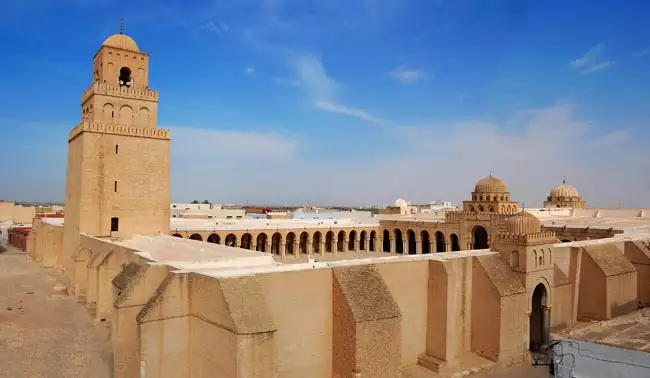
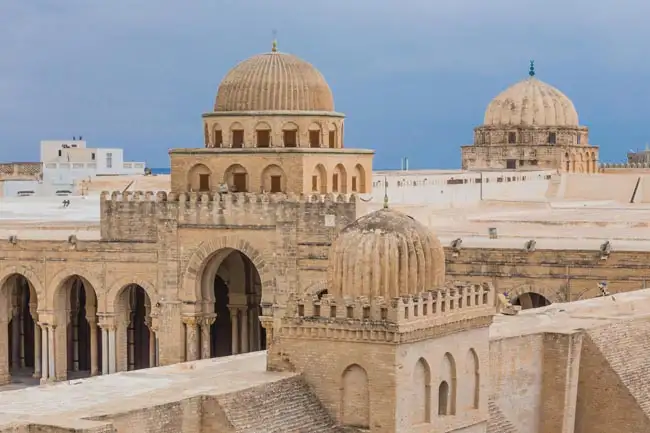
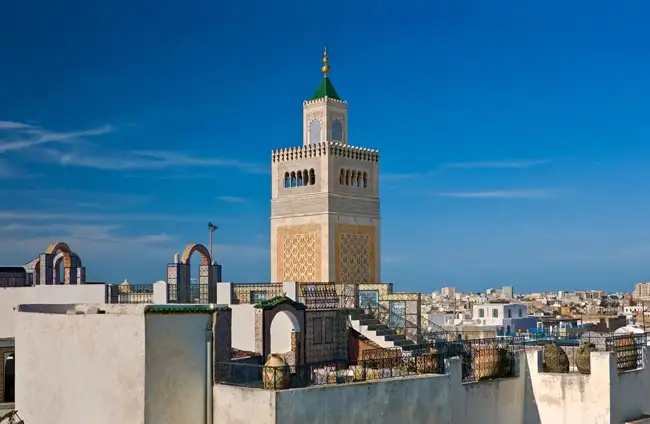
Excellent
Overall Rating
4.7
Extend Your Trip
This tour is part of a series that can be upgraded to make for a longer trip.
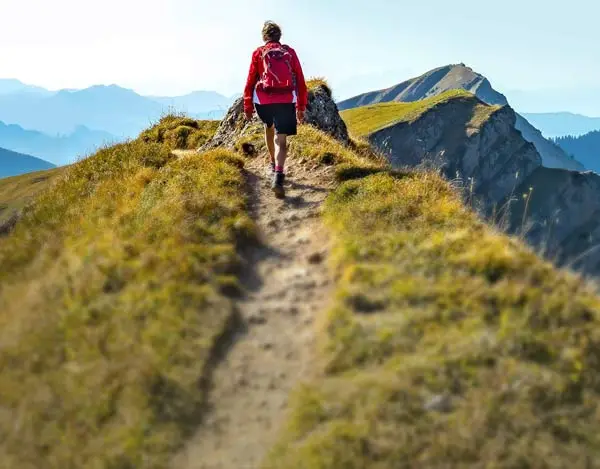
Fast and easy
Book This Tour
Book your unforgettable adventure today! For any questions or advice, don't hesitate to contact us.
Have questions?
1-800-665-3998
- Final payment: Due 90 days prior to departure.
- Deposit: A non-refundable $500 USD Deposit is required at booking.
- Optional Single Supplement: $780 USD (number of singles limited).
(View options forsingle travellers) - Transfering Tour or Date: Transferring to another tour or tour date is only permissible outside of 120 days prior to departure and is subject to a $100 USD change fee.
(Read our cancellation policy)
Choose your departure date:
Prices below are per person, twin-sharing costs in US Dollars (USD). Pricing does not include airfare to/from the tour and any applicable taxes.
Prices below are per person, twin-sharing costs in US Dollars (USD). Pricing does not include airfare to/from the tour and any applicable taxes.
Frequently Asked Questions
- What is the maximum number of participants on a trip?Most of our tours carry a maximum of 18 participants; some tours (ie hiking tours) top out at 16. In the event that we do not achieve our minimum complement by our 90-day deadline, we may offer group members the option of paying a "small-group surcharge" as an alternative to cancellation. If all group members agree, we will confirm the trip at existing numbers; this surcharge is refundable in the event that we ultimately achieve our regular minimum. If the small group surcharge is not accepted, we will offer a refund of your deposit or a different trip of your choice.
- Can I extend my tour either at the beginning or end? What about stopovers?Yes, you can extend your tour either at the beginning or the end and we can book accommodation in our tour hotel. Stopovers are often permitted, depending on air routing. Stopovers usually carry a "stopover" fee levied by the airline.
- How do I make a reservation? How and when do I pay?The easiest way to make a reservation is via our website; during office hours, you are also more than welcome to contact us by telephone.
A non-refundable deposit is payable at the time of booking; if a reservation is made within 90 days, full payment is required. Some trips require a larger deposit. If international airline bookings require a non-refundable payment in order to secure space or the lowest available fare, we will require an increase in deposit equal to the cost of the ticket(s).
Early enrolment is always encouraged as group size is limited and some trips require greater preparation time.
Once we have received your deposit, we will confirm your space and send you a confirmation package containing your trip itinerary, any visa/travel permit related documents, invoice, clothing and equipment recommendations, general information on your destination(s), and forms for you to complete, sign and return to us. Your air e-tickets (if applicable), final hotel list, final trip itinerary, and instructions on how to join your tour, will be sent approximately 2-3 weeks prior to departure. - What about cancellations, refunds, and transfers?Please review our cancellation policy page for details.
- I am a single who prefers my own room. What is a single supplement?All of our tours have a single supplement for those who want to be guaranteed their own room at each location.
This supplement is a reflection of the fact that most hotels around the world do not discount the regular twin-share rate for a room by 50% for only one person occupying a room. Most hotels will give a break on the price, but usually in the range of 25-30% of the twin-share rate. This difference, multiplied by each night, amounts to the single supplement.
The conventional amount can also vary from country to country and some destinations are more expensive than others for single occupancy. In order to be "single friendly," the supplements we apply are not a profit centre for us and we do our best to keep them as reasonable as possible.
On most tours we limit the number of singles available, not to be punitive, but rather because many hotels allow for only a limited number of singles; some smaller hotels at remote locations also have a limited number of single rooms available.
Please note that most single rooms around the world are smaller than twin-share rooms and will likely have only one bed. - Do you have a shared accommodation program?Yes! If you are single traveller and are willing to share, we will do our best to pair you with a same-gender roommate. Please note that should we fail to pair you, we will absorb the single supplement fee and you will default to a single room at no extra charge.
